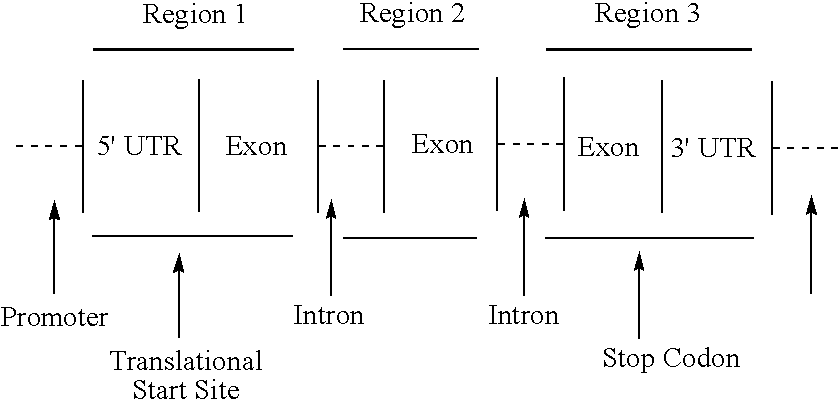Biological containment system
- Summary
- Abstract
- Description
- Claims
- Application Information
AI Technical Summary
Benefits of technology
Problems solved by technology
Method used
Image
Examples
example 1
Chimeric LEC2 Nucleic Acid Construct
[0133] A chimeric LEC2 gene construct, designated pLEC2, was made using standard molecular biology techniques. The construct contains the coding sequence for the Arabidopsis LEC2 polypeptide. pLEC2 contains 5 binding sites for the DNA binding domain upstream activation sequence of the Hap1 transcription factor (UASHap1) located 5′ to and operably linked to a CaMV35S minimal promoter. The CaMV35S minimal promoter is located 5′ to and operably linked to the LEC2 coding sequence. The construct contains an OCS polyA transcription terminator sequence operably linked to the 3′ end of the LEC2 coding sequence. The binding of a transcription factor that possesses a Hap1 DNA binding domain to the UASHap1 is necessary for transcriptional activation of the LEC2 chimeric gene.
example 2
Transgenic Rice Plants
[0134] The pLEC2 plasmid was introduced into the Japonica rice cultivar Kitaake by Agrobacterium tumefaciens mediated transformation using techniques similar to those described in U.S. Pat. No. 6,329,571. Transformants were selected based on resistance to the herbicide bialophos, conferred by a bar gene present on the introduced nucleic acid. After selfing to homozygosity for 3 generations, several transformed plants, designated pLEC2-3-11-10, pLEC2-3-11-12, pLEC2-3-11-13, pLEC2-3-12-2, pLEC2-3-12-4, were selected for further study.
[0135] A construct designated pCR19, containing a chimeric Hap1-VP16 gene and a green fluorescent protein (GFP) reporter gene was introduced into the Kitaake cultivar by the same technique. The chimeric Hap1-VP16 gene contained a rice ubiquitin minimal promoter operably linked to the 5′ end of the Hap1-VP16 coding sequence and an NOS polyA terminator operably linked to the 3′ end of the Hap1-VP16 coding sequence. The amino acid seq...
example 3
Transgenic Soybean Plants
[0142] A soybean plant homozygous for a transgene comprising the LEC2 coding sequence operably linked to 5 copies of a UASHap1 and a 35S minimal promoter was crossed as a female, using pollen from a soybean plant homozygous for a transgene comprising a HAP1-VP16 polypeptide operably linked to an embryo-targeted regulatory sequence. The soybean plant used as a female also is homozygous for a transgene comprising the coding sequence for a tumor necrosis factor receptor polypeptide, operably linked to 5 copies of a UASHap1 and a 35S minimal promoter. See, e.g., U.S. Pat. No. 6,541,610.
[0143] At maturity, F1 seeds are collected and stored under standard conditions. Any tumor necrosis factor receptor expressed in the F1 seeds is extracted. At 7, 14, and 21 days after pollination, some of the embryos and seeds developing on F1 plants are examined under a microscope. Mature seed also are scored for viability and germination and tested for the presence of tumor ne...
PUM
| Property | Measurement | Unit |
|---|---|---|
| Ratio | aaaaa | aaaaa |
| Immunogenicity | aaaaa | aaaaa |
| Sterile | aaaaa | aaaaa |
Abstract
Description
Claims
Application Information
 Login to View More
Login to View More - R&D
- Intellectual Property
- Life Sciences
- Materials
- Tech Scout
- Unparalleled Data Quality
- Higher Quality Content
- 60% Fewer Hallucinations
Browse by: Latest US Patents, China's latest patents, Technical Efficacy Thesaurus, Application Domain, Technology Topic, Popular Technical Reports.
© 2025 PatSnap. All rights reserved.Legal|Privacy policy|Modern Slavery Act Transparency Statement|Sitemap|About US| Contact US: help@patsnap.com

